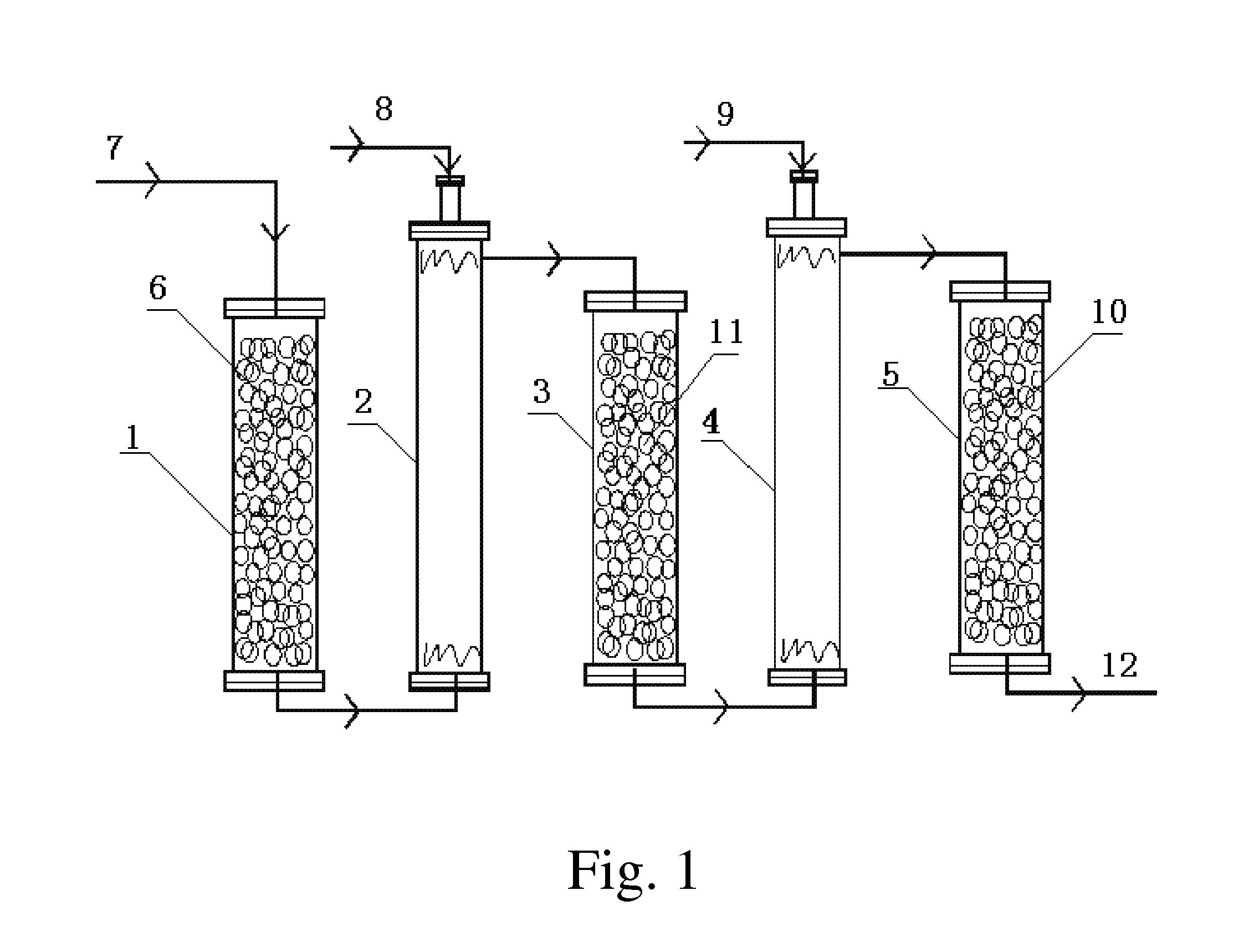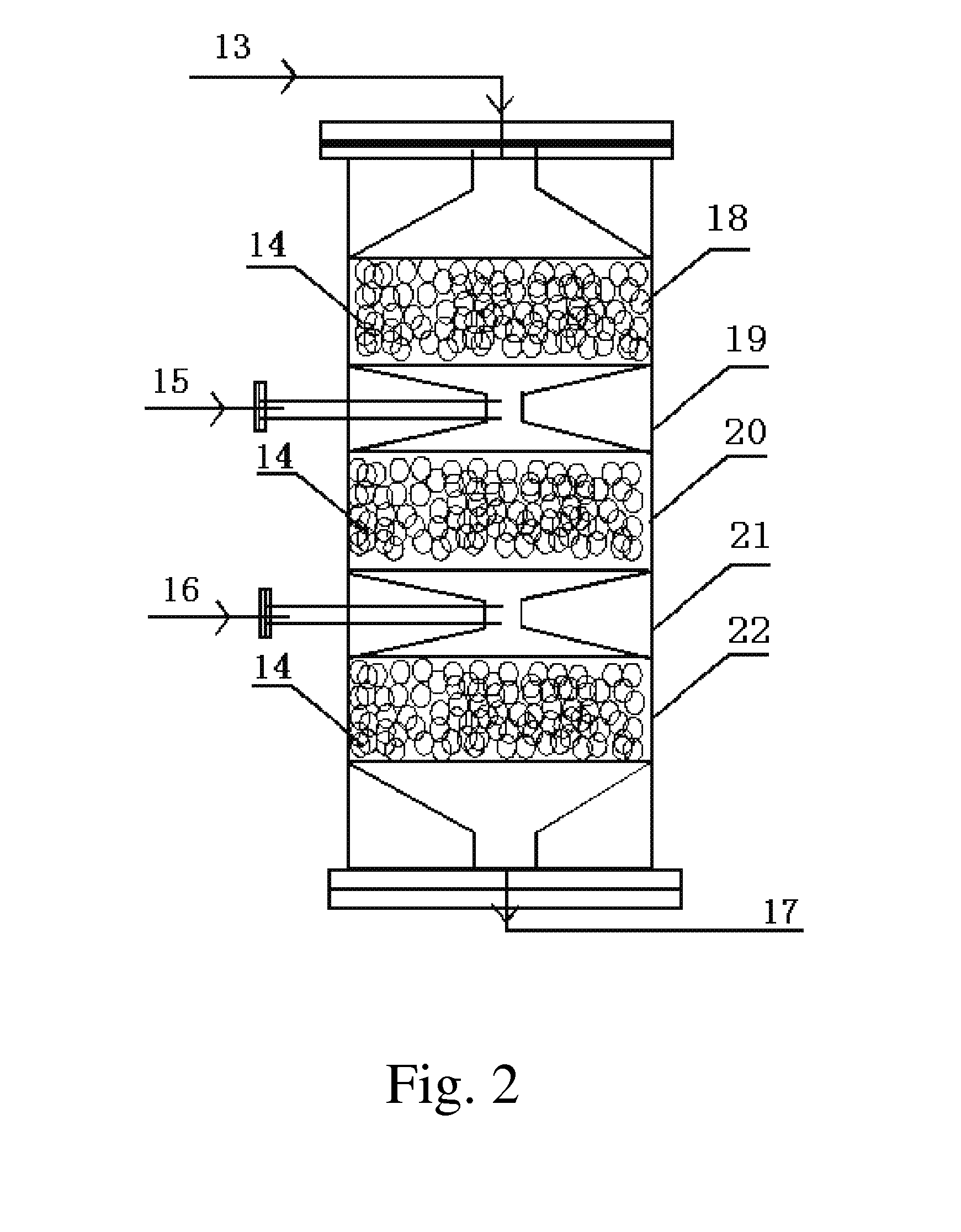Method for preparing vinyl chloride with acetylene and dichlorethane
a technology of dichlorethane and vinyl chloride, which is applied in the preparation of halogenated hydrocarbons, hydrogen halide split-off, organic chemistry, etc., can solve the problems of mercury pollution and environmental pollution, and the pressure is hug
- Summary
- Abstract
- Description
- Claims
- Application Information
AI Technical Summary
Benefits of technology
Problems solved by technology
Method used
Image
Examples
embodiment 1
[0047]1) Acetylene, dichlorethane vapor and hydrogen chloride gas are mixed, and the acetylene, dichlorethane and hydrogen chloride are adjusted with a molar ratio of 1:0.3:0.2, to obtain a raw mixed gas;
2) The raw mixed gas is preheated to 150° C.;
3) The preheated raw mixed gas pass through a reactor containing a catalyst, the catalyst used is activated carbon-supported barium chloride. The reactor adopts a multistage cold shock fixed bed reactor, and adopts a 2-stage reaction, with a cold shock intermediately. The cold shock is performed by a directly injection manner of liquid dichloroethane, to make the temperature of the reactant gas drop to the level accord with the requirement of inlet temperature. The inlet temperature of the bed reactor is controlled to be 150° C., and the outlet temperature is 280° C., to make the conversion ratio of the raw material (in acetylene terms) is up to 80%. Inlet velocity of the raw mixed gas is controlled as per cubic meter of catalyst treating...
embodiment 2
[0048]1) Acetylene, dichlorethane vapor are mixed, and the acetylene, dichlorethane are adjusted with a molar ratio of 1:1, to obtain a raw mixed gas;
2) The raw mixed gas is preheated to 230° C.;
3) the preheated raw mixed gas pass through a reactor containing a catalyst, the catalyst used is activated carbon-supported barium chloride. The reactor adopts a multistage cold shock fixed bed reactor, and adopts a 5 stages reaction, with 4 cold shocks intermediately. The cold shock is performed by cold raw material gas, to make the temperature of the reactant gas drop to the level accord with the requirement of inlet temperature. The inlet temperature of the bed reactor is controlled to be 230° C., and the outlet temperature is 270° C., to make the conversion ratio of the raw material (in acetylene terms) is up to 85%. Inlet velocity of the raw mixed gas is controlled as per cubic meter of catalyst treating 50 cubic meter of raw mixed gas per hour; pressure of the reaction is controlled a...
embodiment 3
[0049]1) Acetylene, dichlorethane vapor and hydrogen chloride gas are mixed, and the acetylene, dichlorethane and hydrogen chloride are adjusted with a molar ratio of 1:0.5:0.1, to obtain a raw mixed gas;
2) The raw mixed gas is preheated to 160° C.;
3) The preheated raw mixed gas pass through a reactor containing a catalyst, the catalyst used is activated carbon-supported barium chloride. The reactor adopts a multistage cold shock fixed bed reactor, and adopts a 3-stage reaction, with 2 cold shocks intermediately (referring to the multistage cold shock fixed bed reactor of a two times cold shock and three stages reaction as shown in FIG. 1, or the multistage cold shock fixed bed reactor having a integration of multistage reactions as shown in FIG. 2). The cold shock is performed by a directly injection manner of liquid dichloroethane, to make the temperature of the reactant gas drop to the level accord with the requirement of inlet temperature. The inlet temperature of the bed reacto...
PUM
| Property | Measurement | Unit |
|---|---|---|
| Temperature | aaaaa | aaaaa |
| Temperature | aaaaa | aaaaa |
| Temperature | aaaaa | aaaaa |
Abstract
Description
Claims
Application Information
 Login to View More
Login to View More - R&D
- Intellectual Property
- Life Sciences
- Materials
- Tech Scout
- Unparalleled Data Quality
- Higher Quality Content
- 60% Fewer Hallucinations
Browse by: Latest US Patents, China's latest patents, Technical Efficacy Thesaurus, Application Domain, Technology Topic, Popular Technical Reports.
© 2025 PatSnap. All rights reserved.Legal|Privacy policy|Modern Slavery Act Transparency Statement|Sitemap|About US| Contact US: help@patsnap.com


